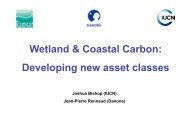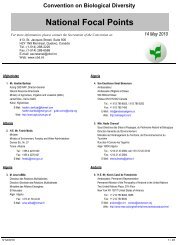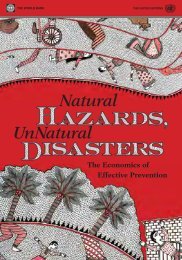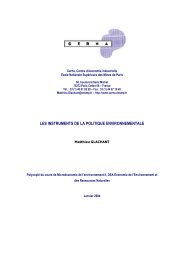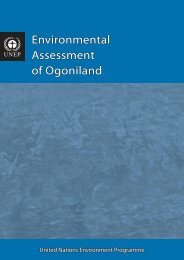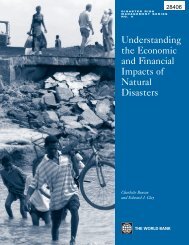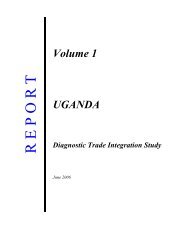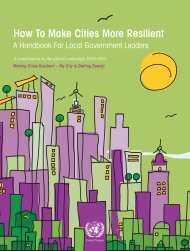Preparing for Climate Change in the Red Sea - IUCN
Preparing for Climate Change in the Red Sea - IUCN
Preparing for Climate Change in the Red Sea - IUCN
Create successful ePaper yourself
Turn your PDF publications into a flip-book with our unique Google optimized e-Paper software.
<strong>Prepar<strong>in</strong>g</strong> <strong>for</strong> <strong>Climate</strong> <strong>Change</strong> <strong>in</strong> <strong>the</strong><br />
<strong>Red</strong> <strong>Sea</strong><br />
Recognis<strong>in</strong>g early impacts through perceptions of dive tourists and dive<br />
operators <strong>in</strong> Egypt.<br />
N.A. Marshall, P.A. Marshall, A. Abdulla, A. Rouphael, and A. Ali<br />
<strong>IUCN</strong> RESILIENCE SCIENCE GROUP WORKING PAPER SERIES n o 10
<strong>Prepar<strong>in</strong>g</strong> <strong>for</strong> <strong>Climate</strong> <strong>Change</strong><br />
<strong>in</strong> <strong>the</strong> <strong>Red</strong> <strong>Sea</strong><br />
Recognis<strong>in</strong>g early impacts through perceptions of dive<br />
tourists and dive operators <strong>in</strong> Egypt.<br />
N.A. Marshall, P.A. Marshall, A. Abdulla, A. Rouphael,<br />
and A. Ali<br />
<strong>IUCN</strong> RESILIENCE SCIENCE GROUP WORKING PAPER SERIES n o 10
The designation of geographical entities <strong>in</strong> this book, and <strong>the</strong> presentation of <strong>the</strong> material, do not imply<br />
<strong>the</strong> expression of any op<strong>in</strong>ion whatsoever on <strong>the</strong> part of <strong>IUCN</strong> concern<strong>in</strong>g <strong>the</strong> legal status of any<br />
country, territory, or area, or of its authorities, or concern<strong>in</strong>g <strong>the</strong> delimitation of its frontiers or<br />
boundaries.<br />
The views expressed <strong>in</strong> this publication do not necessarily reflect those of <strong>IUCN</strong>.<br />
This publication has been made possible <strong>in</strong> part by fund<strong>in</strong>g from Kuoni Travel Hold<strong>in</strong>g Ltd.<br />
This publication is a contribution of <strong>the</strong> Mar<strong>in</strong>e Biodiversity and Conservation Science Group of <strong>the</strong><br />
<strong>IUCN</strong> Global Mar<strong>in</strong>e Program.<br />
Published by:<br />
Copyright:<br />
<strong>IUCN</strong>, Gland, Switzerland<br />
© 2009 International Union <strong>for</strong> Conservation of Nature and Natural Resources<br />
Reproduction of this publication <strong>for</strong> educational or o<strong>the</strong>r non-commercial purposes is authorized without<br />
prior written permission from <strong>the</strong> copyright holder provided <strong>the</strong> source is fully acknowledged.<br />
Reproduction of this publication <strong>for</strong> resale or o<strong>the</strong>r commercial purposes is prohibited without prior<br />
written permission of <strong>the</strong> copyright holder.<br />
Citation: Marshall, N.A., Marshall, P.A., Abdulla, A., Rouphael, A., and Ali, A. (2009). <strong>Prepar<strong>in</strong>g</strong> <strong>for</strong><br />
<strong>Climate</strong> <strong>Change</strong>: Recognis<strong>in</strong>g early impacts through perceptions of dive tourists and dive operators <strong>in</strong><br />
<strong>the</strong> Egyptian <strong>Red</strong> <strong>Sea</strong>. Gland, Switzerland: <strong>IUCN</strong>. 52pp.<br />
ISBN: 978-2-8317-1218-5<br />
Cover photo: Front Cover: Diver enjoy<strong>in</strong>g <strong>the</strong> experience of div<strong>in</strong>g on biodiverse and<br />
healthy Egyptian coral reefs. Photo by HEPCA<br />
Back Cover: Close up of Anthias, <strong>the</strong> signature fish species of <strong>the</strong> <strong>Red</strong><br />
<strong>Sea</strong>.<br />
Available from:<br />
<strong>IUCN</strong> (International Union<br />
<strong>for</strong> Conservation of Nature)<br />
Publications Services<br />
Rue Mauverney 28<br />
1196 Gland<br />
Switzerland<br />
Tel +41 22 999 0000<br />
Fax +41 22 999 0020<br />
books@iucn.org<br />
www.iucn.org/publications<br />
A catalogue of <strong>IUCN</strong> publications is also available.
Table of Contents<br />
Foreword .................................................................................................................... v<br />
Acknowledgements ................................................................................................... vi<br />
Executive Summary .................................................................................................. 1<br />
Introduction ............................................................................................................... 3<br />
Tourism is a major source of economic activity...................................................... 3<br />
<strong>Climate</strong> change br<strong>in</strong>gs a new threat to tourism ...................................................... 3<br />
<strong>Climate</strong> change impacts on <strong>the</strong> tourism <strong>in</strong>dustry .................................................... 3<br />
<strong>Prepar<strong>in</strong>g</strong> <strong>for</strong> climate change <strong>in</strong> <strong>the</strong> <strong>Red</strong> <strong>Sea</strong> ........................................................ 5<br />
Method ...................................................................................................................... 7<br />
Results ...................................................................................................................... 9<br />
A. Tourist Results .................................................................................................. 9<br />
Demography ...................................................................................................... 9<br />
Dive experience ............................................................................................... 10<br />
Dive experience <strong>in</strong> <strong>the</strong> <strong>Red</strong> <strong>Sea</strong> ...................................................................... 11<br />
Sensitivity to coral degradation ........................................................................ 13<br />
Awareness of climate change issues ............................................................... 16<br />
B. Dive Operator Results ..................................................................................... 20<br />
Discussion ............................................................................................................... 37<br />
References .............................................................................................................. 39<br />
iv
Foreword<br />
Tourism is considered to be a highly climate sensitive sector and <strong>the</strong> tourism <strong>in</strong>dustry has a key role to<br />
play <strong>in</strong> confront<strong>in</strong>g <strong>the</strong> challenges of climate change. The relation between climate change and tourism<br />
is twofold: climate change impacts on tourism and tourism impact climate change.<br />
<strong>Climate</strong> affects a wide range of environmental resources that are essential attraction factors <strong>for</strong> tourism.<br />
The regional manifestations of climate change such as coral reef damage, extreme wea<strong>the</strong>r patterns or<br />
water shortages have potentially disastrous effects on many tourism dest<strong>in</strong>ations and tourism products.<br />
Kuoni acknowledge that <strong>the</strong>ir bus<strong>in</strong>ess has an impact on <strong>the</strong> climate and are attempt<strong>in</strong>g to counter this<br />
impact and try<strong>in</strong>g to take responsibility <strong>for</strong> <strong>the</strong> emissions caused by <strong>the</strong>ir bus<strong>in</strong>ess activities. Kuoni<br />
wants to be part of <strong>the</strong> solution to climate change, by reduc<strong>in</strong>g its green house gas emissions as well as<br />
by help<strong>in</strong>g <strong>the</strong> communities where tourism represents a major economic source to prepare <strong>for</strong> and adapt<br />
to <strong>the</strong> chang<strong>in</strong>g climate.<br />
In this context, it is critical to understand <strong>the</strong> potential impacts of climate change <strong>in</strong> <strong>the</strong> Egyptian <strong>Red</strong><br />
<strong>Sea</strong>. Rais<strong>in</strong>g awareness of this threat among local tour operators and resource managers is crucial to<br />
plan actions that can potentially mitigate future impacts to coral reefs and mar<strong>in</strong>e-based tourism.<br />
In partnership with local tour operators, <strong>IUCN</strong>, <strong>the</strong> Hurghada Environmental Protection and<br />
Conservation Association (HEPCA) and Kuoni work toge<strong>the</strong>r to address three issues: firstly to assess<br />
<strong>the</strong> vulnerability of <strong>the</strong> tourism <strong>in</strong>dustry to climate change. Secondly, to tra<strong>in</strong> and empower local capacity<br />
to monitor and manage coral reefs <strong>in</strong> <strong>the</strong> face of climate change. Thirdly, to undertake an environmental<br />
education and public awareness campaign address<strong>in</strong>g <strong>the</strong> impacts of anthropogenic activities on mar<strong>in</strong>e<br />
habitats.<br />
This publication should help to develop practical guidance and capacity build<strong>in</strong>g <strong>for</strong> climate change<br />
adaptation. It is designed to provide a pragmatic plat<strong>for</strong>m to streng<strong>the</strong>n <strong>the</strong> capacity of professionals to<br />
understand and respond effectively to <strong>the</strong> global challenges of climate change <strong>in</strong> tourism dest<strong>in</strong>ations.<br />
We hope that this publication will support ef<strong>for</strong>ts to ma<strong>in</strong>stream climate change considerations <strong>in</strong>to<br />
tourism plann<strong>in</strong>g and management. We fur<strong>the</strong>r believe that <strong>the</strong> tourism sector, through its major<br />
contribution to global development, can <strong>in</strong>fluence o<strong>the</strong>r sectors by send<strong>in</strong>g important signals to<br />
governments, <strong>in</strong>dustries and <strong>the</strong> public that climate mitigation and adaptation measures are not only<br />
vital <strong>for</strong> our future, but also make economic sense.<br />
Matthias Leis<strong>in</strong>ger<br />
Head of Corporate Responsibility<br />
Kuoni Travel Hold<strong>in</strong>g Ltd.<br />
v
Acknowledgements<br />
Fund<strong>in</strong>g <strong>for</strong> this project was gratefully received from Kuoni Travel Group Ltd; <strong>IUCN</strong> Mar<strong>in</strong>e Biodiversity<br />
and Conservation Science Group and Global Mar<strong>in</strong>e Program; and from CSIRO, <strong>Climate</strong> Adaptation<br />
Flagship. We s<strong>in</strong>cerely thank <strong>the</strong> tireless and dedicated field ef<strong>for</strong>ts of Richard Anscombe, Heba<br />
Shawky, and Amr Ali. F<strong>in</strong>ally, we are grateful <strong>for</strong> all <strong>the</strong> time and ef<strong>for</strong>t <strong>in</strong>vested <strong>in</strong> respond<strong>in</strong>g to <strong>the</strong><br />
surveys by <strong>the</strong> dive tourists and dive operators that were <strong>in</strong>terviewed.<br />
vi
Executive Summary<br />
Tourism generates important economic activity globally and is a major source of <strong>for</strong>eign exchange<br />
<strong>in</strong>come <strong>in</strong> many countries. Yet, climate change has <strong>the</strong> potential to permanently alter <strong>the</strong> attraction and<br />
value of many tourism dest<strong>in</strong>ations and substantially impact <strong>the</strong> <strong>in</strong>come streams and social benefits<br />
derived from tourism. These impacts can be m<strong>in</strong>imised if tourism operators, sectors and tourismdependent<br />
communities understand <strong>the</strong>ir vulnerability to climate change, and take steps to adapt to<br />
predicted changes. Some of <strong>the</strong> more immediate and manageable changes are likely to result from<br />
changes <strong>in</strong> awareness and attitudes among tourists, and <strong>the</strong>se factors are major drivers of dest<strong>in</strong>ation<br />
and activity choice. Here we test <strong>for</strong> early <strong>in</strong>dications of <strong>the</strong>se potential climate change impacts among<br />
<strong>Red</strong> <strong>Sea</strong> tourists and tourism operators as a first step to develop<strong>in</strong>g climate adaptation strategies <strong>for</strong> this<br />
sector. Our aims were to: (i) identify whe<strong>the</strong>r climate change awareness and attitudes were currently<br />
evident <strong>in</strong> dive tourists visit<strong>in</strong>g <strong>the</strong> <strong>Red</strong> <strong>Sea</strong> region, (ii) assess <strong>in</strong>dustry awareness of client attitudes, and<br />
(iii) evaluate <strong>the</strong> implications of <strong>the</strong>se results <strong>for</strong> development of climate adaptation strategies <strong>for</strong> <strong>the</strong><br />
<strong>Red</strong> <strong>Sea</strong> tourism <strong>in</strong>dustry <strong>in</strong> Egypt.<br />
We <strong>in</strong>terviewed 150 dive tourists <strong>in</strong> <strong>the</strong> Egyptian <strong>Red</strong> <strong>Sea</strong> <strong>for</strong> <strong>the</strong>ir awareness and attitudes towards<br />
climate change and coral reef condition, and 35 dive operators <strong>for</strong> <strong>the</strong>ir op<strong>in</strong>ion of tourist attitudes and<br />
awareness. Our data suggest that changes <strong>in</strong> awareness and attitudes are already apparent <strong>in</strong> <strong>the</strong><br />
Egyptian <strong>Red</strong> <strong>Sea</strong> tourism sector. Dive tourists are strongly aware of environmental issues and climate<br />
change, and place significant importance on environmental quality and <strong>the</strong> susta<strong>in</strong>ability profile of<br />
tourism operators <strong>in</strong> mak<strong>in</strong>g holiday decisions. In contrast, dive operators generally ascribe only a<br />
moderate level of environmental awareness to <strong>the</strong>ir clients and believe <strong>the</strong>m to be relatively <strong>in</strong>sensitive<br />
to ecosystem health and <strong>the</strong> susta<strong>in</strong>ability profile of operators. This ‘perception gap’ between clients and<br />
operators <strong>in</strong>creases <strong>the</strong> risk that dive operators <strong>in</strong> <strong>the</strong> Egyptian <strong>Red</strong> <strong>Sea</strong> will experience early impacts of<br />
climate change. This study reveals <strong>the</strong> nature of <strong>in</strong>itial awareness and attitud<strong>in</strong>al change among tourists<br />
visit<strong>in</strong>g <strong>the</strong> <strong>Red</strong> <strong>Sea</strong>, and lays <strong>the</strong> foundations <strong>for</strong> early adaptation by <strong>the</strong> <strong>Red</strong> <strong>Sea</strong> tourism <strong>in</strong>dustry.<br />
1
Introduction<br />
Tourism is a major source of economic activity<br />
Tourism generates important economic activity globally and is a major source of <strong>for</strong>eign exchange<br />
<strong>in</strong>come <strong>in</strong> many countries (Simpson, et al., 2008). In Egypt, tourism generates an estimated US$ 7.8<br />
billion annually (equivalent to approximately 6% of national GDP), as well as provid<strong>in</strong>g employment <strong>for</strong><br />
12% of <strong>the</strong> national work <strong>for</strong>ce (AFP, 2007).<br />
Much of <strong>the</strong> revenue from tourism <strong>in</strong> Egypt is derived from <strong>the</strong> <strong>Red</strong> <strong>Sea</strong> region. The <strong>Red</strong> <strong>Sea</strong> is<br />
<strong>in</strong>ternationally renowned <strong>for</strong> some of <strong>the</strong> most spectacular and diverse coral reefs and mar<strong>in</strong>e life on <strong>the</strong><br />
planet. Egypt hosts <strong>the</strong> largest live-aboard fleet <strong>in</strong> <strong>the</strong> world. Some 540,000 people annually come from<br />
all over <strong>the</strong> world to dive <strong>in</strong> <strong>the</strong> Egyptian <strong>Red</strong> <strong>Sea</strong>, provid<strong>in</strong>g grow<strong>in</strong>g demand <strong>for</strong> tourism <strong>in</strong>frastructure<br />
and deliver<strong>in</strong>g important <strong>for</strong>eign revenue to <strong>the</strong> regional and national economy (USAID, 2008).<br />
<strong>Climate</strong> change br<strong>in</strong>gs a new threat to tourism<br />
The tourism <strong>in</strong>dustry around <strong>the</strong> globe has had to face many challenges over <strong>the</strong> last decade. Terrorist<br />
attacks, <strong>the</strong> lung disease SARS, <strong>the</strong> war <strong>in</strong> <strong>the</strong> Middle East and years of ris<strong>in</strong>g energy prices are some<br />
of <strong>the</strong> more dramatic. Aga<strong>in</strong>st <strong>the</strong> backdrop of largely unpredictable external shocks, <strong>the</strong> tourism sector<br />
is now fac<strong>in</strong>g <strong>the</strong> prospect of a new and pervasive challenge: climate change (Nicholls, 2004). Tourism<br />
is often strongly dependent on environmental assets, mak<strong>in</strong>g it particularly sensitive to <strong>the</strong> impacts of<br />
climate change. Fur<strong>the</strong>r, <strong>the</strong> effects of climate change have <strong>the</strong> potential to permanently alter <strong>the</strong><br />
attraction and value of a holiday region (Simpson, et al., 2008).<br />
Coral reefs are particularly sensitive to changes <strong>in</strong> climate (Marshall & Johnson, 2007). As a result of<br />
<strong>in</strong>creas<strong>in</strong>g sea water temperatures and ultra-violet (UV) radiation, mass coral bleach<strong>in</strong>g has occurred<br />
worldwide, devastat<strong>in</strong>g reefs <strong>in</strong> some regions <strong>in</strong>clud<strong>in</strong>g <strong>the</strong> Maldives, Seychelles and Palau and lead<strong>in</strong>g<br />
some experts to claim that coral reefs are ‘<strong>in</strong> crisis’ (Belwood, et al., 2004; Hoegh-Guldberg, 2007).<br />
Fur<strong>the</strong>r, as a result of <strong>the</strong> uptake of carbon dioxide from <strong>the</strong> atmosphere, ocean acidification<br />
exacerbates <strong>the</strong> threat to mar<strong>in</strong>e animals and plants that produce calcium carbonate skeletons (Marshall<br />
& Johnson, 2007). Whilst <strong>the</strong> Egyptian <strong>Red</strong> <strong>Sea</strong> has so far escaped a major mass bleach<strong>in</strong>g event,<br />
ecologists work<strong>in</strong>g <strong>in</strong> <strong>the</strong> region suggest that it is only a matter of time be<strong>for</strong>e <strong>the</strong> effects of climate<br />
change manifest here (NCS, 2006; Rouphael & Abdulla, 2007).<br />
<strong>Climate</strong> change impacts on <strong>the</strong> tourism <strong>in</strong>dustry<br />
A recent review by <strong>the</strong> United Nations Environment Program (Simpson, et al., 2008) recognised four<br />
broad categories of climate change impacts likely to affect tourism dest<strong>in</strong>ations, sector competitiveness<br />
and bus<strong>in</strong>ess susta<strong>in</strong>ability. We use additional reports (Forsyth, et al. 2007; Ehmer & Heyman, 2008)<br />
and our own study and experience to expand this conceptual model to five categories: direct climatic<br />
impacts, <strong>in</strong>direct environmental change impacts, impacts of mitigation policies on tourist mobility,<br />
<strong>in</strong>direct societal change impacts, and attitud<strong>in</strong>al and behavioural change impacts.<br />
1. Direct climatic impacts<br />
<strong>Climate</strong> will have direct impacts on tourism by alter<strong>in</strong>g dest<strong>in</strong>ation appeal and by affect<strong>in</strong>g <strong>in</strong>put costs<br />
(Simpson, et al., 2008). Dest<strong>in</strong>ation appeal will be affected where climate itself is a significant tourism<br />
resource (i.e. probability of ‘sunny days’) and where <strong>the</strong> wea<strong>the</strong>r determ<strong>in</strong>es <strong>the</strong> suitability of important<br />
3
tourism activities. Input costs are often dependent on environmental conditions, such as temperature<br />
(<strong>for</strong> heat<strong>in</strong>g/cool<strong>in</strong>g), ra<strong>in</strong>fall (availability of water) and frequency of extreme wea<strong>the</strong>r events<br />
(<strong>in</strong>frastructure repair and <strong>in</strong>surance costs). <strong>Change</strong>s to climate could result <strong>in</strong> both negative and<br />
positive impacts (e.g. more/less ‘sunny days’), depend<strong>in</strong>g on <strong>the</strong> location and nature of activities<br />
undertaken at a tourism dest<strong>in</strong>ation.<br />
2. Indirect environmental change impacts<br />
Many tourism activities are dependent on environmental assets, such as beaches or coral reefs. <strong>Climate</strong><br />
change is expected to alter many aspects of <strong>the</strong> natural and built environment, creat<strong>in</strong>g a range of<br />
<strong>in</strong>direct impacts <strong>for</strong> tourism, most of which are likely to be negative. Examples of <strong>in</strong>direct environmental<br />
impacts from climate change <strong>in</strong>clude biodiversity losses, loss of coral cover, reduced reef aes<strong>the</strong>tic,<br />
decreased fisheries production as well as a decl<strong>in</strong>e <strong>in</strong> ecosystem services such as coastal protection<br />
and beach replenishment.<br />
3. Impacts of mitigation policies on tourist mobility<br />
National or <strong>in</strong>ternational mitigation policies that seek to reduce <strong>the</strong> impact of tourism on natural<br />
resources or reduce carbon emissions may have an impact on tourist flows (Simpson, et al., 2008;<br />
Gossl<strong>in</strong>g, et al., 2008). For example, <strong>the</strong> numbers of tourists to a tourist site might be more tightly<br />
managed given that <strong>the</strong> site may be especially prone to climate change damage. Additionally, mitigation<br />
policies may foster tourist attitudes that result <strong>in</strong> lower propensity <strong>for</strong> long-haul travel or participation <strong>in</strong><br />
energy-<strong>in</strong>tensive activities.<br />
4. Indirect societal change impacts.<br />
<strong>Climate</strong> change has <strong>the</strong> potential to cause massive social upheaval as a result of impacts on future<br />
economic growth and political stability. As a result, climate change is commonly regarded as a national<br />
and <strong>in</strong>ternational security risk that will <strong>in</strong>tensify with warm<strong>in</strong>g especially <strong>in</strong> regions where tourism is very<br />
important. Develop<strong>in</strong>g countries <strong>in</strong> particular are likely to experience <strong>in</strong>direct societal change impacts<br />
(Stern, 2006; Simpson, et al., 2008). Worsen<strong>in</strong>g situations of social unrest will make each region even<br />
more unpalatable <strong>for</strong> tourism (Hall, et al., 2004; UNEP, 2009).<br />
5. Awareness and attitud<strong>in</strong>al impacts<br />
As consensus grows about <strong>the</strong> imperative to take action on climate change, <strong>in</strong>dividuals are adopt<strong>in</strong>g<br />
new attitudes and behaviours <strong>in</strong> response to new laws and community expectations (‘social norms’).<br />
These changes will <strong>in</strong>fluence <strong>the</strong> decisions tourists make about dest<strong>in</strong>ations, modes of travel, activities<br />
and <strong>the</strong> bus<strong>in</strong>esses <strong>the</strong>y patronise (Forsyth, et al., 2007). <strong>Change</strong>s <strong>in</strong> awareness and attitudes can be<br />
expected to be expressed earlier, and perhaps even more dramatically, than <strong>the</strong> impacts <strong>in</strong>cluded <strong>in</strong> <strong>the</strong><br />
above four categories. For example, a dest<strong>in</strong>ation with a poor image <strong>for</strong> susta<strong>in</strong>ability and climate<br />
friendl<strong>in</strong>ess could rapidly fall from grace <strong>in</strong> <strong>the</strong> perception of grow<strong>in</strong>g numbers of travellers with a strong<br />
environmental conscience (e.g. see corporate responsibility assessments at http://www.kuonigroup.com).<br />
In contrast to <strong>the</strong> potential importance of this category of impact, is its amenability to<br />
<strong>in</strong>fluence by <strong>the</strong> tourism sector. By chang<strong>in</strong>g operat<strong>in</strong>g practices and with <strong>the</strong> support of appropriate<br />
communication activities, particular tourism bus<strong>in</strong>esses, dest<strong>in</strong>ations or sectors can actually position<br />
<strong>the</strong>mselves to benefit from changes <strong>in</strong> tourist’ attitudes ra<strong>the</strong>r than suffer negative impacts.<br />
4
<strong>Prepar<strong>in</strong>g</strong> <strong>for</strong> climate change <strong>in</strong> <strong>the</strong> <strong>Red</strong> <strong>Sea</strong><br />
As our awareness of climate change has <strong>in</strong>creased, so, too, has our need to understand <strong>the</strong> threat it<br />
poses and our vulnerability to it. <strong>Climate</strong> change cannot be fully averted and we must understand,<br />
prepare <strong>for</strong> and adapt to its <strong>in</strong>evitable effects. Adaptation is essential if <strong>the</strong> tourism sector <strong>in</strong> <strong>the</strong><br />
Egyptian <strong>Red</strong> <strong>Sea</strong> is to reduce its vulnerability to climate change and m<strong>in</strong>imise negative changes <strong>in</strong><br />
tourism visitation to <strong>the</strong> region (Armitage, et al., 2008; Nicholls, 2004; Williams & Pons<strong>for</strong>d, 2009).<br />
We focus here on understand<strong>in</strong>g <strong>the</strong> potential <strong>for</strong> impacts on <strong>the</strong> <strong>Red</strong> <strong>Sea</strong> tourism <strong>in</strong>dustry <strong>in</strong> Egypt<br />
result<strong>in</strong>g from attitud<strong>in</strong>al change related to climate change. We hope that this <strong>in</strong><strong>for</strong>mation can assist <strong>the</strong><br />
dive tourism <strong>in</strong>dustry <strong>in</strong> <strong>the</strong> <strong>Red</strong> <strong>Sea</strong> to respond to <strong>the</strong> emerg<strong>in</strong>g challenge of climate change. We<br />
provide dive tourism operators <strong>in</strong> <strong>the</strong> <strong>Red</strong> <strong>Sea</strong> region with <strong>in</strong><strong>for</strong>mation about dive tourists and <strong>the</strong>ir<br />
climate awareness and attitudes so as to assist operators to better plan <strong>for</strong> <strong>the</strong> effects of climate<br />
change. We exam<strong>in</strong>e also <strong>the</strong> perceptions of dive operators to gauge <strong>the</strong> extent to which <strong>the</strong>y are aware<br />
of changes <strong>in</strong> attitudes and awareness of tourists <strong>in</strong> <strong>the</strong>ir bus<strong>in</strong>ess operations and plann<strong>in</strong>g.<br />
This study is a prelim<strong>in</strong>ary survey to <strong>in</strong><strong>for</strong>m fur<strong>the</strong>r work on adaptation <strong>in</strong> <strong>the</strong> dive tourism sector.<br />
Specific aims of <strong>the</strong> study were to: (i) test <strong>for</strong> evidence of awareness and attitudes of tourists that could<br />
affect choice of dest<strong>in</strong>ation, activity or bus<strong>in</strong>ess, (ii) assess <strong>the</strong> perceptions of <strong>the</strong> dive tourism <strong>in</strong>dustry<br />
about <strong>the</strong> awareness and attitudes of tourism clients and (iii) evaluate <strong>the</strong> implications of <strong>the</strong>se results<br />
<strong>for</strong> adaptation strategies <strong>in</strong> <strong>the</strong> <strong>Red</strong> <strong>Sea</strong> dive tourism <strong>in</strong>dustry.<br />
5
Method<br />
Surveys were developed to assess <strong>the</strong> awareness and attitudes of dive tourists to environmental<br />
conditions and climate change issues, and to exam<strong>in</strong>e <strong>the</strong> perceptions of dive operators about <strong>the</strong><br />
awareness and attitudes of dive tourists. Statements were created to reflect various perceptions and<br />
respondents were asked to rate how strongly <strong>the</strong>y agreed with each statement us<strong>in</strong>g a 4-po<strong>in</strong>t Likert<br />
scale (strongly agree, agree, disagree, strongly disagree). Some open ended questions were also<br />
<strong>in</strong>cluded. This survey structure is most efficient <strong>for</strong> obta<strong>in</strong><strong>in</strong>g large amounts of data <strong>in</strong> a relatively short<br />
time (Likert, 1968).<br />
The dive tourist surveys were designed so that <strong>the</strong> follow<strong>in</strong>g <strong>in</strong><strong>for</strong>mation could be elicited: (i)<br />
demographic characteristics, (ii) dive experience, (iii) dive experience <strong>in</strong> <strong>the</strong> red sea, (iv) sensitivity to<br />
coral degradation, (v) awareness of climate change impacts, (vi) environmental awareness, (vii) dive<br />
holiday preferences, (viii) bus<strong>in</strong>ess opportunities <strong>for</strong> <strong>the</strong> <strong>Red</strong> <strong>Sea</strong> region (see appendix 1 <strong>for</strong> a copy of<br />
<strong>the</strong> survey).<br />
The dive operator surveys were designed so that <strong>the</strong> follow<strong>in</strong>g <strong>in</strong><strong>for</strong>mation could be elicited: (i)<br />
demographic characteristics, (ii) dive experience, (iii) perceptions of coral condition <strong>in</strong> <strong>the</strong> <strong>Red</strong> <strong>Sea</strong>, (iv)<br />
perceptions of dive tourists’ sensitivity to coral degradation, (vi) environmental awareness, (vii)<br />
awareness of climate impacts, (viii) awareness of tourist preferences, (ix) prepar<strong>in</strong>g <strong>for</strong> climate changes<br />
(see appendix 2 <strong>for</strong> a copy of <strong>the</strong> survey).<br />
A team of tra<strong>in</strong>ed <strong>in</strong>terviewers was established through a local NGO (Hurghada Environment Protection<br />
and Conservation Association; see http://www.hepca.com.eg). The team randomly identified and<br />
approached day operators and live-aboard dive operators from 6 dest<strong>in</strong>ations along <strong>the</strong> Egyptian <strong>Red</strong><br />
<strong>Sea</strong> Coastl<strong>in</strong>e that <strong>in</strong>clude El Gouna, Saffaga, Qusier, Marsa Alam, Wadi Lahmi and Live-Aboards (see<br />
Map 1). Over <strong>the</strong> course of 1 month (May 2009), surveys were adm<strong>in</strong>istered to a proportionate number<br />
of tourists and dive tourist operators. The response rate of tourists was 80% and <strong>the</strong> response rate of<br />
dive operators was 60%. Refusals were most often due to language barriers. Overall, 150 dive tourists<br />
and 35 dive operators were sampled.<br />
7
8<br />
Map 1. Map of <strong>the</strong> Nor<strong>the</strong>rn <strong>Red</strong> <strong>Sea</strong>
Results<br />
A. Tourist Results<br />
Demography<br />
Most (72%) of <strong>the</strong> 150 dive tourists surveyed were aboard a day-trip operation and <strong>the</strong> rema<strong>in</strong><strong>in</strong>g 28%<br />
were on a live-aboard operation. Dive tourists were of 19 different nationalities (see Figure 1). Most<br />
were from Germany (34%) and Brita<strong>in</strong> (30%) with o<strong>the</strong>rs com<strong>in</strong>g from Holland (5%), Belgium (4%),<br />
Poland (3%) and Norway (1%). Most tourists were between 36-46 years of age (32%; see Figure 2).<br />
Most had completed <strong>the</strong>ir school<strong>in</strong>g to <strong>the</strong> age of 18 years (65%), and 50% had undertaken fur<strong>the</strong>r<br />
educational studies.<br />
Figure 1. Nationality of dive tourists<br />
9
Figure 2. The age distribution of dive tourists<br />
Dive experience<br />
Divers were generally ‘advanced’ <strong>in</strong> <strong>the</strong>ir dive qualifications (46%), with only 13% recently qualified.<br />
Whilst 11% had not dived <strong>in</strong> any o<strong>the</strong>r region, most respondents had dived elsewhere, some <strong>in</strong> over 10<br />
o<strong>the</strong>r dive regions (7%) (see Figure 3).<br />
Figure 3. The number of o<strong>the</strong>r regions that tourists have dived <strong>in</strong><br />
10
Dive experience <strong>in</strong> <strong>the</strong> <strong>Red</strong> <strong>Sea</strong><br />
Tourists ranked big fish (mean=2.85) as <strong>the</strong> most important factor when rat<strong>in</strong>g <strong>the</strong>ir dive or snorkel<br />
experience. O<strong>the</strong>r factors <strong>in</strong> <strong>the</strong>ir order of importance were: pretty coral <strong>for</strong>mations (mean=2.61), lots of<br />
healthy coral (mean=2.50), visibility (water clarity; mean=2.40), and many pretty fish (mean=2.35).<br />
The majority of tourists (79%) had some previous dive experience of <strong>the</strong> <strong>Red</strong> <strong>Sea</strong>. Whilst many had<br />
mostly only dived once <strong>in</strong> <strong>the</strong> region be<strong>for</strong>e (21%), some divers were return<strong>in</strong>g rout<strong>in</strong>ely and some<br />
return<strong>in</strong>g up to 34 times (see Figure 5). Most divers were bas<strong>in</strong>g <strong>the</strong>mselves from Hurghada/El Gouna<br />
(60%; see Figure 6).<br />
Divers were asked to rate <strong>the</strong> quality of <strong>the</strong>ir recent dive experiences <strong>in</strong> <strong>the</strong> region on a scale of 1-10<br />
where 10 was <strong>the</strong> best div<strong>in</strong>g <strong>the</strong>y could ever imag<strong>in</strong>e. Whilst responses ranged from 1-10 (see Figure<br />
4), <strong>the</strong> most frequent response was 8 (mean=7.7 and s.e.=0.1).<br />
Many divers had heard that, “coral condition <strong>in</strong> <strong>the</strong> region was great” (66%). Nearly half of visitors (47%)<br />
reported that <strong>the</strong>y expected <strong>the</strong>re to be more coral, but most were not disappo<strong>in</strong>ted with <strong>the</strong> colour of<br />
corals (59%), nor with <strong>the</strong> numbers of fish (figure 62%). The majority of divers who were return visitors<br />
reported that coral condition <strong>in</strong> <strong>the</strong> region had not decl<strong>in</strong>ed or improved, and was essentially unchanged<br />
(70%; see Figure 7). Most divers would recommend <strong>the</strong> Egyptian <strong>Red</strong> <strong>Sea</strong> region to <strong>the</strong>ir div<strong>in</strong>g friends<br />
<strong>for</strong> holidays (84%). Overall, divers thought <strong>the</strong> coral reef was beautiful (66%), but few strongly agreed<br />
with <strong>the</strong> statement that <strong>the</strong> “coral was beautiful overall” (see Figure 8).<br />
Figure 4. Tourist rat<strong>in</strong>gs of <strong>the</strong>ir recent dives <strong>in</strong> <strong>the</strong> <strong>Red</strong> <strong>Sea</strong><br />
11
Figure 5. The number of dive trips to <strong>the</strong> <strong>Red</strong> <strong>Sea</strong> region<br />
Figure 6. Div<strong>in</strong>g bases of tourists<br />
12
Figure 7. The impression of coral condition from return-tourists<br />
Figure 8. The impression of coral condition from dive tourists<br />
Sensitivity to coral degradation<br />
Half of <strong>the</strong> divers reported that <strong>the</strong>y noticed a lot of ‘dead look<strong>in</strong>g coral’ (50%) (see Figure 9). About half<br />
(45%) suggested that <strong>the</strong>y would not notice if some (
Figure 9. Tourists’ impressions of <strong>the</strong> amount of dead-look<strong>in</strong>g coral<br />
Figure 10. Tourists’ sensitivity to some coral degradation<br />
14
Figure 11. Tourists’ sensitivity to 25% coral degradation<br />
Figure 12. Tourists’ sensitivity to 50% coral degradation<br />
15
Figure 13. Tourists’ sensitivity to severe coral degradation<br />
Awareness of climate change issues<br />
Over 80% of tourists <strong>in</strong>dicated that <strong>the</strong>y were very concerned about climate change and its impacts<br />
around <strong>the</strong> world. The majority of <strong>the</strong> dive tourists were very climate aware where 73% implied that <strong>the</strong>y<br />
read a lot about climate change impacts around <strong>the</strong> world (see Figure 14). The majority of respondents<br />
had heard about coral bleach<strong>in</strong>g (75%; see Figure 15).<br />
Figure 14. The extent to which tourists read about climate<br />
change impacts<br />
16
Environmental awareness<br />
Figure 15. The extent to which tourists have heard about coral<br />
bleach<strong>in</strong>g<br />
Tourists were asked to list <strong>the</strong> first, second and third most important threats to <strong>the</strong> <strong>Red</strong> <strong>Sea</strong> region.<br />
Those threats listed as <strong>the</strong> most important <strong>in</strong>cluded dive tourists (23%), pollution (23%) and urban<br />
development (20%; o<strong>the</strong>r factors made up 44%).<br />
Pollution (24%) and over-fish<strong>in</strong>g (24%) were most frequently cited as <strong>the</strong> second most important threats.<br />
<strong>Climate</strong> change impacts were listed as <strong>the</strong> third most important threat to <strong>the</strong> region (10%).<br />
Plann<strong>in</strong>g processes <strong>for</strong> tourists<br />
Overwhelm<strong>in</strong>gly (90%) divers stated that <strong>the</strong>y are more likely to choose a dive operation that is<br />
‘environmentally friendly’ (see Figure 16). The majority said that <strong>the</strong>y plan <strong>the</strong>ir holidays accord<strong>in</strong>g to <strong>the</strong><br />
dive experience <strong>the</strong>y expect (79%). Over half <strong>the</strong> tourists that were <strong>in</strong>terviewed said that climate change<br />
issues were important <strong>for</strong> choos<strong>in</strong>g <strong>the</strong>ir diver operation (59%; see Figure 17). More than half suggested<br />
that how climate change was managed (<strong>in</strong> general) was an important factor <strong>in</strong> select<strong>in</strong>g <strong>the</strong>ir holiday<br />
dest<strong>in</strong>ation (59%; see Figure 18). The majority of tourists (76%) <strong>in</strong>dicated that <strong>the</strong>y often talk about coral<br />
reef health and fish numbers with o<strong>the</strong>r divers <strong>the</strong>y meet (see Figure 19).<br />
17
Figure 16. The extent to which tourists are likely to choose a dive<br />
operation that is ‘environmentally friendly’<br />
Figure 17. The extent to which tourists <strong>in</strong>corporate climate change<br />
issues <strong>in</strong>to choos<strong>in</strong>g a dive operation<br />
18
Figure 18. The importance of climate change management to tourists<br />
<strong>in</strong> select<strong>in</strong>g <strong>the</strong>ir holiday<br />
Figure 19. The extent to which tourists communicate about coral reef<br />
health and fish numbers with o<strong>the</strong>r tourists<br />
Features attract<strong>in</strong>g dive tourists to <strong>the</strong> <strong>Red</strong> <strong>Sea</strong> region<br />
Accord<strong>in</strong>g to this survey, div<strong>in</strong>g is certa<strong>in</strong>ly <strong>the</strong> ma<strong>in</strong> attraction <strong>for</strong> divers visit<strong>in</strong>g <strong>the</strong> <strong>Red</strong> <strong>Sea</strong> region<br />
(89%; see Figure 20). The majority of divers were not participat<strong>in</strong>g <strong>in</strong> any o<strong>the</strong>r ‘<strong>in</strong>terest<strong>in</strong>g activity’ <strong>in</strong> <strong>the</strong><br />
region (81%; see Figure 21). However, when asked what <strong>the</strong>ir most important factor <strong>in</strong> choos<strong>in</strong>g <strong>the</strong><br />
<strong>Red</strong> <strong>Sea</strong> <strong>for</strong> a holiday dest<strong>in</strong>ation, divers <strong>in</strong>cluded <strong>the</strong> div<strong>in</strong>g experience (43%), proximity to home (34%)<br />
and <strong>the</strong> good wea<strong>the</strong>r (22%).<br />
19
Figure 20. The extent to which div<strong>in</strong>g is <strong>the</strong> ma<strong>in</strong> attraction to <strong>the</strong><br />
region<br />
Figure 21. The extent to which o<strong>the</strong>r activities <strong>in</strong> <strong>the</strong> region is<br />
<strong>in</strong>terest<strong>in</strong>g to divers<br />
B. Dive Operator Results<br />
Demography<br />
Of <strong>the</strong> 35 dive operators surveyed, 50% conducted a day-trip style operation only, and 25% conducted a<br />
live-aboard style operation whilst 25% operated as both (see Figure 22). Half of <strong>the</strong> dive operator<br />
respondents owned <strong>the</strong> dive bus<strong>in</strong>ess, while <strong>the</strong> rema<strong>in</strong>der <strong>in</strong>terviewed were employees. Some (3.6%)<br />
bus<strong>in</strong>esses were very small with only 1 or 2 employees, whilst o<strong>the</strong>rs (3.6%) were very large with<br />
around 300 employees (see Figure 23). The mean number of employees per bus<strong>in</strong>ess was 38 (s.e.=11<br />
20
employees), although <strong>the</strong> most frequent response was 15 employees. Some (10.7%) bus<strong>in</strong>ess did not<br />
own any dive vessels, whereas some (3.6%) owned up to 11 vessels (see Figure 24). The mean<br />
number of dive vessels held by bus<strong>in</strong>esses was 2 (s.e.=0.5), with <strong>the</strong> most frequent response of 1.<br />
Thirty two per cent of <strong>the</strong> operators sampled were Egyptian (see Figure 25). O<strong>the</strong>r operators were<br />
mostly British (25%) or German (14%). Most operators were between 36-45 years of age (50%; see<br />
Figure 26).<br />
Figure 22. Style of dive operations<br />
Figure 23. Number of employees with<strong>in</strong> each operation<br />
21
Figure 24. Number of div<strong>in</strong>g vessels with<strong>in</strong> each operation<br />
Figure 25. Nationality of dive operators<br />
22
Dive operator experience<br />
Figure 26. Age distribution of dive operators<br />
The experience of dive operators <strong>in</strong> <strong>the</strong> <strong>Red</strong> <strong>Sea</strong> region ranged from 1 to 22 years. The mean value was<br />
10 years (s.e.=0.9 years). Whilst some dive operators were very new to <strong>the</strong> local region (7%), most dive<br />
operators were extremely familiar with <strong>the</strong> region, logg<strong>in</strong>g up to 7,000 dives <strong>in</strong> <strong>the</strong> Egyptian <strong>Red</strong> <strong>Sea</strong><br />
(see Figure 27). The mean number of dives <strong>for</strong> operators <strong>in</strong> <strong>the</strong> region was 1996 (s.e. = 321 dives).<br />
Whilst some operators had never dived <strong>in</strong> any o<strong>the</strong>r region (25%), most (75%) had dived elsewhere,<br />
and some <strong>in</strong> over 10 o<strong>the</strong>r regions (11%; see Figure 28).<br />
Figure 27. Dive experience of dive operators <strong>in</strong> <strong>the</strong> <strong>Red</strong> <strong>Sea</strong><br />
23
Figure 28. Dive experience of dive operators <strong>in</strong> o<strong>the</strong>r regions of<br />
<strong>the</strong> world<br />
Perceptions of coral condition <strong>in</strong> <strong>the</strong> region<br />
Dive operators thought <strong>the</strong>re was a lot of ‘dead look<strong>in</strong>g coral <strong>in</strong> <strong>the</strong> region’ (60%; see Figure 29). They<br />
rated coral condition <strong>in</strong> <strong>the</strong> region as ‘mostly good’ (36%) and ‘about 50% <strong>in</strong> good condition’ (57%; see<br />
Figure 30). Nearly 80% of operators reported some decl<strong>in</strong>e <strong>in</strong> coral condition dur<strong>in</strong>g <strong>the</strong>ir experience <strong>in</strong><br />
<strong>the</strong> <strong>Red</strong> <strong>Sea</strong> region (see Figure 31) and most operators (71%) believed that <strong>the</strong> coral reefs <strong>in</strong> <strong>the</strong> region<br />
were not <strong>in</strong> ‘great’ condition (see Figure 32) but did th<strong>in</strong>k that fish numbers <strong>in</strong> <strong>the</strong> region were impressive<br />
(61%; see Figure 33).<br />
Figure 29. Dive operators’ impression of <strong>the</strong> amount of deadlook<strong>in</strong>g<br />
coral<br />
24
Figure 30. Dive operators’ impression of coral condition<br />
Figure 31. Dive operators’ impression of coral condition over time<br />
25
Figure 32. Dive operators’ assessment of whe<strong>the</strong>r coral reefs <strong>in</strong><br />
<strong>the</strong> <strong>Red</strong> <strong>Sea</strong> are <strong>in</strong> great condition<br />
Figure 33. Dive operators’ assessment of whe<strong>the</strong>r fish numbers<br />
<strong>in</strong> <strong>the</strong> <strong>Red</strong> <strong>Sea</strong> are impressive<br />
Perceptions of dive tourists’ sensitivity to change <strong>in</strong> reef condition<br />
Dive operators thought that tourists were notic<strong>in</strong>g coral decl<strong>in</strong>e <strong>in</strong> <strong>the</strong> region (78%; see Figure 34). Yet,<br />
most operators (71%) thought that loss of some coral <strong>in</strong> <strong>the</strong> region would not detract from <strong>the</strong> overall<br />
dive experience <strong>for</strong> tourists (see Figure 35). About 40% of operators thought that a 25% decl<strong>in</strong>e <strong>in</strong> coral<br />
cover would not be noticed (see Figure 36). Most operators thought that loss of half of <strong>the</strong> coral and<br />
most of <strong>the</strong> coral <strong>in</strong> <strong>the</strong> region would detract from a tourist’s experience (64% and 79% respectively; see<br />
Figures 37 and 38).<br />
26
Dive operators thought that dive tourists had unrealistic expectations about coral colour (57%; see<br />
Figure 39). Dive operators were worried that if coral condition decl<strong>in</strong>ed <strong>the</strong>n tourist numbers would be<br />
affected (89%; see Figure 40), s<strong>in</strong>ce most operators thought that reef condition will determ<strong>in</strong>e tourist<br />
numbers <strong>in</strong> <strong>the</strong> future (86%; see Figure 41).<br />
Figure 34. Dive operators’ assessment of whe<strong>the</strong>r tourists are notic<strong>in</strong>g<br />
coral decl<strong>in</strong>e<br />
Figure 35. Dive operators’ assessment of tourists’ sensitivity to some<br />
(
Figure 36. Dive operators’ assessment of tourists’ sensitivity to some<br />
(25%) coral decl<strong>in</strong>e<br />
Figure 37. Dive operators’ assessment of tourists’ sensitivity to 50%<br />
coral decl<strong>in</strong>e<br />
28
Figure 38. Dive operators’ assessment of tourists’ sensitivity to significant<br />
coral decl<strong>in</strong>e<br />
Figure 39. Dive operators’ perceptions of tourists expectations of reef<br />
condition<br />
29
Figure 40. Dive operators’ concerns regard<strong>in</strong>g loss of tourist numbers<br />
as a result of coral decl<strong>in</strong>e<br />
Figure 41. Dive operators’ beliefs that reef condition will determ<strong>in</strong>e<br />
tourist numbers <strong>in</strong> <strong>the</strong> future<br />
Environmental awareness of tourism operators<br />
Pollution, commercial fish<strong>in</strong>g and urban development were consistently rated by tourism operators as<br />
<strong>the</strong> first and second most important threats to <strong>the</strong> <strong>Red</strong> <strong>Sea</strong> region. <strong>Climate</strong> change issues, commercial<br />
fish<strong>in</strong>g and dive tourism were <strong>the</strong> factors most often ranked as <strong>the</strong> third most important threats (25%,<br />
21% and 18% respectively).<br />
30
Awareness of climate impacts<br />
Most dive operators (68%) have seen evidence of coral bleach<strong>in</strong>g <strong>in</strong> <strong>the</strong> <strong>Red</strong> <strong>Sea</strong> region (see Figure<br />
42). Most (93%) were worried about <strong>the</strong> future of coral reefs <strong>in</strong> <strong>the</strong> region as a result of climate change<br />
(see Figure 43). Dive operators read a lot about climate change impacts (92%; see Figure 44) and most<br />
(96%) were <strong>in</strong>terested <strong>in</strong> learn<strong>in</strong>g more about <strong>the</strong> impacts of climate change on coral reefs (see Figure<br />
45).<br />
Figure 42. Proportion of tourist operators that have witnessed coral<br />
bleach<strong>in</strong>g <strong>in</strong> <strong>the</strong> region<br />
Figure 43. The extent to which tourist operators are concerned about<br />
climate change and its impacts on local coral reefs<br />
31
Figure 44. The extent to which tourist operators read about climate change<br />
impacts<br />
Figure 45. The extent to which tourist operators are <strong>in</strong>terested <strong>in</strong> learn<strong>in</strong>g<br />
more about climate change impacts on local coral reefs<br />
Operator’s perception of tourist attitudes<br />
About half <strong>the</strong> dive operators (57%) <strong>in</strong>dicated that tourists want to talk about coral health more than any<br />
o<strong>the</strong>r subject (see Figure 46). However, most (69%) felt that climate change issues were not important<br />
to <strong>the</strong>ir div<strong>in</strong>g clients (see Figure 47). Most operators (85%) did not th<strong>in</strong>k that tourists select <strong>the</strong>ir<br />
32
holidays by consider<strong>in</strong>g how climate change is managed <strong>in</strong> an area (see Figure 48). Nor did most (57%)<br />
th<strong>in</strong>k that tourists consider how environmentally friendly dive operators are <strong>in</strong> choos<strong>in</strong>g an operator <strong>for</strong><br />
<strong>the</strong>ir div<strong>in</strong>g holiday (see Figure 49). Operators mostly (82%) thought that tourists were un<strong>in</strong>terested <strong>in</strong><br />
<strong>the</strong>ir own climate footpr<strong>in</strong>t whilst on holidays (see Figure 50).<br />
Figure 46. Tourist operator perceptions of <strong>the</strong> extent to which tourists want to<br />
talk about coral reef health<br />
Figure 47. Tourist operator perceptions of <strong>the</strong> extent to which climate change<br />
issues are important to tourists <strong>in</strong> choos<strong>in</strong>g a dive operation<br />
33
Figure 48. Tourist operator perceptions of <strong>the</strong> extent to which tourists consider<br />
climate change management <strong>in</strong> an area <strong>in</strong> select<strong>in</strong>g <strong>the</strong>ir holiday dest<strong>in</strong>ation<br />
Figure 49. Tourist operator perceptions of <strong>the</strong> extent to which tourists are<br />
<strong>in</strong>terested <strong>in</strong> how environmentally friendly dive operators are<br />
34
Figure 50. Tourist operators perceptions of <strong>the</strong> extent to which tourists are concerned<br />
about <strong>the</strong>ir own climate footpr<strong>in</strong>t when travell<strong>in</strong>g<br />
Future options <strong>for</strong> dive tourism bus<strong>in</strong>esses <strong>in</strong> <strong>the</strong> <strong>Red</strong> <strong>Sea</strong> Region<br />
Dive tourism operators thought that <strong>the</strong>re were not many options <strong>for</strong> tourists <strong>in</strong> <strong>the</strong> region o<strong>the</strong>r than<br />
div<strong>in</strong>g (78%; see Figure 51). About 25% of dive operators <strong>in</strong>dicated that <strong>the</strong>y would close <strong>the</strong>ir bus<strong>in</strong>ess<br />
if <strong>the</strong>re was major damage to <strong>the</strong>ir ma<strong>in</strong> dive sites from climate change with<strong>in</strong> <strong>the</strong> next 5 years. The<br />
rema<strong>in</strong><strong>in</strong>g operators suggested that <strong>the</strong>y would ei<strong>the</strong>r cont<strong>in</strong>ue <strong>the</strong>ir operation as is (21%) or look <strong>for</strong><br />
new reefs (25%). About 35% of operators <strong>in</strong>dicated that <strong>the</strong>y would close <strong>the</strong>ir bus<strong>in</strong>ess <strong>in</strong> response to<br />
major climate-<strong>in</strong>duced damage of <strong>the</strong>ir reefs with<strong>in</strong> <strong>the</strong> next 5-10 years.<br />
35
Figure 51. Tourist operator perceptions of <strong>the</strong> extent to which <strong>the</strong>re are <strong>in</strong>terest<strong>in</strong>g<br />
th<strong>in</strong>gs <strong>in</strong> <strong>the</strong> region <strong>for</strong> tourists o<strong>the</strong>r than div<strong>in</strong>g<br />
36
Discussion<br />
Our results suggest that changes <strong>in</strong> dive tourist’ awareness and attitudes are already be<strong>in</strong>g realised <strong>in</strong><br />
<strong>the</strong> <strong>Red</strong> <strong>Sea</strong> region. Dive tourists are generally well educated, cosmopolitan and are mostly very aware<br />
of environmental conditions and climate change issues. Nearly half of <strong>the</strong> dive tourists <strong>in</strong>dicated that<br />
<strong>the</strong>y would be able to detect changes <strong>in</strong> coral condition of around 25%. This sensitivity to coral condition<br />
is consistent with a broader trend <strong>in</strong> environmental awareness of tourists worldwide (DRET, 2008;<br />
Simpson, et al., 2008). Fur<strong>the</strong>rmore, <strong>the</strong> majority of dive tourists <strong>in</strong> our survey were <strong>in</strong>terested <strong>in</strong> dive<br />
operators that were promot<strong>in</strong>g energy efficiency, environmental friendl<strong>in</strong>ess and climate awareness.<br />
Results suggest that whilst climate change may have yet to impact <strong>the</strong> Egyptian coral reef ecosystem, it<br />
is already hav<strong>in</strong>g impact on <strong>the</strong> perceptions and choices of dive tourists.<br />
The dive <strong>in</strong>dustry <strong>in</strong> <strong>the</strong> <strong>Red</strong> <strong>Sea</strong> region is relatively unaware of <strong>the</strong> changes <strong>in</strong> tourist’ awareness and<br />
attitude and has not yet <strong>in</strong>corporated <strong>in</strong><strong>for</strong>mation about <strong>the</strong> ‘new dive tourist’ <strong>in</strong>to <strong>the</strong>ir bus<strong>in</strong>ess th<strong>in</strong>k<strong>in</strong>g.<br />
Dive operators focus more on <strong>the</strong> traditional dive tourist that is less environmentally and climate aware.<br />
Dive operators <strong>in</strong> <strong>the</strong> <strong>Red</strong> <strong>Sea</strong> region generally th<strong>in</strong>k that dive tourists have unrealistic expectations<br />
about coral condition, are unlikely to notice coral degradation, do not consider climate issues when<br />
choos<strong>in</strong>g a dive operation, and do not consider <strong>the</strong>ir own climate footpr<strong>in</strong>t when travell<strong>in</strong>g. Hence,<br />
operators are potentially cater<strong>in</strong>g <strong>for</strong> less than half of <strong>the</strong>ir clients´ needs and <strong>in</strong>terests. Operators that<br />
do not adapt to this emerg<strong>in</strong>g ‘climate aware’ market risk los<strong>in</strong>g market share to more responsive<br />
competitors (Berrittella, et al., 2006).<br />
Research conducted <strong>in</strong> <strong>the</strong> UK has found that although tourists are climate aware, <strong>the</strong>ir behaviour has<br />
not yet changed <strong>in</strong> l<strong>in</strong>e with <strong>the</strong>se convictions (DRET, 2008). Long haul travel to tourist dest<strong>in</strong>ations has<br />
not decl<strong>in</strong>ed <strong>in</strong> any way even though tourists are aware of its climate impact. This is encourag<strong>in</strong>g <strong>for</strong><br />
dive tourism operators <strong>in</strong> <strong>the</strong> <strong>Red</strong> <strong>Sea</strong> region; <strong>the</strong>re is likely to be a lag period be<strong>for</strong>e tourist behavioural<br />
change <strong>in</strong> <strong>the</strong> region is expressed. This should give dive operators more time to prepare. On <strong>the</strong> o<strong>the</strong>r<br />
hand, Egyptian sites can be labelled as short haul trips to <strong>the</strong> European visitor as compared with dive<br />
trips to <strong>the</strong> Indian Ocean, Asia Pacific, or <strong>the</strong> Caribbean.<br />
Adapt<strong>in</strong>g to climate change requires adequately anticipat<strong>in</strong>g, and prepar<strong>in</strong>g <strong>for</strong>, change. Some<br />
<strong>in</strong>dividuals and some <strong>in</strong>dustries will be better able to plan and reorganise than o<strong>the</strong>rs depend<strong>in</strong>g on <strong>the</strong>ir<br />
capacity to adapt (Marshall, 2008). Enhanc<strong>in</strong>g adaptive capacity can significantly reduce risks of<br />
adverse impacts from future and unpredictable events. Characteristics that contribute to adaptive<br />
capacity <strong>in</strong>clude possess<strong>in</strong>g creativity and <strong>in</strong>novation (<strong>for</strong> identify<strong>in</strong>g solutions or adaptation options;<br />
Folke, et al., 2005; Hiedanpaa, 2005), test<strong>in</strong>g and experiment<strong>in</strong>g options (Walters, 1997; Armitage, et<br />
al., 2008), us<strong>in</strong>g effective feedback mechanisms (Young, et al., 2006), us<strong>in</strong>g adaptive management<br />
approaches (Holl<strong>in</strong>g, 2004), emotional and f<strong>in</strong>ancial flexibility <strong>for</strong> absorb<strong>in</strong>g <strong>the</strong> costs of change<br />
(Gunderson, 1999; Marshall, 2008), and be<strong>in</strong>g able to reorganise given novel <strong>in</strong><strong>for</strong>mation (Abel, et al.,<br />
2006). These characteristics can be actively targeted <strong>for</strong> development and enhancement as part of<br />
strategic ef<strong>for</strong>ts to build capacity to adapt to climate change. These features provide <strong>the</strong> elements of a<br />
conceptual framework <strong>for</strong> strategic ef<strong>for</strong>ts to <strong>in</strong>crease adaptive capacity <strong>in</strong> sectors such as <strong>the</strong> <strong>Red</strong> <strong>Sea</strong><br />
tourism <strong>in</strong>dustry.<br />
Adaptive capacity <strong>in</strong> <strong>the</strong> Egyptian tourism sector can be enhanced. For example, access<strong>in</strong>g <strong>in</strong><strong>for</strong>mation<br />
about <strong>the</strong> future, such as <strong>in</strong><strong>for</strong>mation from this report, reduces <strong>the</strong> risks associated with it and can help<br />
identify opportunities (Grothmann & Patt, 2005). The nature and extent of dependency on natural<br />
37
esources is ano<strong>the</strong>r major <strong>in</strong>fluence on adaptive capacity (Marshall, et al., 2009; Marshall, et al., 2007).<br />
Tourism operations with <strong>the</strong> flexibility to ‘switch’ between tourism activities <strong>in</strong> response to altered<br />
conditions, <strong>for</strong> example, will be better equipped to deal with more permanent changes such as <strong>the</strong><br />
effects of a shift <strong>in</strong> climate. For example, switch<strong>in</strong>g from coral reef div<strong>in</strong>g to technical div<strong>in</strong>g may be an<br />
option <strong>for</strong> some dive operators to reta<strong>in</strong>/<strong>in</strong>crease diver numbers and/or enhance diver experience.<br />
Develop<strong>in</strong>g a range of strategic bus<strong>in</strong>ess skills (such as plann<strong>in</strong>g and reorganis<strong>in</strong>g) can also mitigate<br />
aga<strong>in</strong>st overly dependent resource sectors (Dessai, et al., 2005; Marshall, 2008). There is strong<br />
evidence from o<strong>the</strong>r sectors that good networks and leadership will be important <strong>in</strong> help<strong>in</strong>g <strong>in</strong>dividuals<br />
and sectors adapt to future conditions (Adger, et al., 2005; Gunderson, et al., 2006; Howden, et al.,<br />
2007; Nelson, et al., 2007).<br />
Partnerships are fundamental to <strong>the</strong> success of <strong>the</strong> adaptation process. Industry associations, <strong>for</strong><br />
example, foster collaboration by provid<strong>in</strong>g venues and opportunities to enhance network<strong>in</strong>g both with<strong>in</strong><br />
<strong>the</strong> <strong>in</strong>dustry (<strong>in</strong>ternally) and with local government, community and o<strong>the</strong>r locally-based <strong>in</strong>dustries<br />
(externally). Industry associations can also support <strong>the</strong>ir constituents through provid<strong>in</strong>g assistance with<br />
bus<strong>in</strong>ess plann<strong>in</strong>g, assessments of adaptation options and with reorganis<strong>in</strong>g. Partnerships that<br />
collaboratively learn and encourage creativity whilst shar<strong>in</strong>g <strong>the</strong> purpose of climate adaptation are<br />
critical <strong>for</strong> identify<strong>in</strong>g, implement<strong>in</strong>g and review<strong>in</strong>g adaptation options. Develop<strong>in</strong>g adaptation plans and<br />
identify<strong>in</strong>g actions <strong>in</strong> partnerships will also help to identify and achieve broader <strong>in</strong>dustry goals (Howden,<br />
et al., 2007; Vogel, et al., 2007).<br />
Adapt<strong>in</strong>g to climate change will not always mean prepar<strong>in</strong>g <strong>for</strong> <strong>the</strong> worst; <strong>in</strong> some cases it may also<br />
mean prepar<strong>in</strong>g to take advantage of new conditions (Patt & Dessai, 2005; V<strong>in</strong>cent, 2007). As <strong>for</strong><br />
negative impacts, flexibility and responsiveness are needed to realise potential benefits. (Fankhauser, et<br />
al., 1999; Fenton, et al., 2007; Johnson & Marshall, 2007). Explor<strong>in</strong>g <strong>the</strong> potential <strong>for</strong> positive as well as<br />
negative outcomes from climate change is important <strong>in</strong> development of climate adaptation plans.<br />
The results of this study provide a foundation <strong>for</strong> <strong>the</strong> development of adaptation strategies by <strong>the</strong> <strong>Red</strong><br />
<strong>Sea</strong> tourism <strong>in</strong>dustry. We have elucidated potential impacts on dive tourism <strong>in</strong> <strong>the</strong> <strong>Red</strong> <strong>Sea</strong> as a result<br />
of a mismatch between <strong>the</strong> awareness and attitudes of dive tourists visit<strong>in</strong>g <strong>the</strong> <strong>Red</strong> <strong>Sea</strong> and <strong>the</strong><br />
perceptions of <strong>the</strong> dive <strong>in</strong>dustry. This <strong>in</strong>itial analysis of <strong>the</strong> early manifestation of climate change issues<br />
can help <strong>the</strong> <strong>Red</strong> <strong>Sea</strong> tourism <strong>in</strong>dustry understand aspects of <strong>the</strong>ir vulnerability to climate change, and<br />
use it as <strong>the</strong> foundation <strong>for</strong> adaptation plann<strong>in</strong>g. Through early awareness and pro-active adaptation,<br />
<strong>in</strong>dustry sectors such as <strong>the</strong> <strong>Red</strong> <strong>Sea</strong> tourism <strong>in</strong>dustry can hope to m<strong>in</strong>imise impacts and capitalise on<br />
any opportunities presented by this newest of challenges: climate change.<br />
38
References<br />
Abel, N., Cumm<strong>in</strong>g, D.M. and Anderies, J. (2006). ‘Collapse and Reorganization <strong>in</strong> Social-Ecological<br />
Systems: Questions, Some Ideas, and Policy Implications.’ Ecology and Society 11:17. [onl<strong>in</strong>e]<br />
<br />
Adger, N.W., Saleemul, H., Brown, K., Conway, D. and Hulme, M. (2003). ‘Adaptation to climate change<br />
<strong>in</strong> <strong>the</strong> develop<strong>in</strong>g world.’ Progress <strong>in</strong> Development Studies 3:179-195.<br />
Adger, W.N., Arnell, N.W. and Tompk<strong>in</strong>s, E.L. (2005). ‘Adapt<strong>in</strong>g to climate change: perspectives across<br />
scales.’ Global Environmental <strong>Change</strong> 15:75-76.<br />
AFP. ‘Idyllic holiday dest<strong>in</strong>ations raise climate change alarm’ [onl<strong>in</strong>e news article] (2 October 2007)<br />
. Accessed 7<br />
September 2009.<br />
Armitage, D., Marschke, M. and Plummer, R. (2008). ‘Adaptive co-management and <strong>the</strong> paradox of<br />
learn<strong>in</strong>g.’ Global Environmental <strong>Change</strong> 18:86-98.<br />
Bellwood, D.R., Hughes, T.P., Folke, C. and Nystrom, M. (2004). ‘Confront<strong>in</strong>g <strong>the</strong> Coral Reef Crisis.’<br />
Nature 429:827-833.<br />
Berrittella, M., Bigano, A., Roson, R. and Tol, R.S.J. (2006). ‘A general equilibrium analysis of climate<br />
change impacts on tourism’. Tourism Management 27:913-924.<br />
Dessai, S., Lu, X. and Risbey, J.S. (2005). ‘On <strong>the</strong> role of climate scenarios <strong>for</strong> adaptation plann<strong>in</strong>g’.<br />
Global Environmental <strong>Change</strong> 15:87-97.<br />
DRET (2008). Tourism and <strong>Climate</strong> <strong>Change</strong> - A Framework <strong>for</strong> Action. Australia: Australian<br />
Government, Department of Resources, Energy and Tourism (Ed.) [onl<strong>in</strong>e report],<br />
.<br />
Ehmer, P. and Heymann, E. (2008). ‘<strong>Climate</strong> change and tourism: Where will <strong>the</strong> journey end?’ Deutsch<br />
Bank Research [onl<strong>in</strong>e report] . Accessed 12 September 2009.<br />
Fenton, D.M., Young, M. and Johnson, V.Y. (1998). ‘Re-Present<strong>in</strong>g <strong>the</strong> Great Barrier Reef to Tourists:<br />
Implications <strong>for</strong> Tourist Experience and Evaluation of Coral Reef Environments’. Leisure Sciences<br />
20:177-192.<br />
Folke, C., Hahn, T., Olsson, P. and Norberg J. (2005). ‘Adaptive Governance of Social-Ecological<br />
Systems’. Annual Review of Environment and Resources 30:441-473.<br />
Forsyth, P., Dwyer, L., and Spurr, R. (2007). <strong>Climate</strong> <strong>Change</strong> Policies and Australian Tourism: Scop<strong>in</strong>g<br />
Study of <strong>the</strong> Economic Aspects. Gold Coast, Australia: Centre <strong>for</strong> Tourism Economics and Policy<br />
Research. Susta<strong>in</strong>able Tourism Cooperative Research Centre.<br />
Gra<strong>in</strong>ger, A., Staf<strong>for</strong>d Smith, M., Squires, V.R. and Glenn, E.P. (2000). ‘Desertification, and climate<br />
change: <strong>the</strong> case <strong>for</strong> greater convergence’. Mitigation and Adaptation Strategies <strong>for</strong> Global <strong>Change</strong><br />
5:361-377.<br />
39
Grothmann, T. and Patt, A. (2005). ‘Adaptive capacity and human cognition: The process of <strong>in</strong>dividual<br />
adaptation to climate change’. Global Environmental <strong>Change</strong> 15:199-213.<br />
Gunderson, L. (1999). ‘Resilience, Flexibility and Adaptive Management - Antidotes <strong>for</strong> Spurious<br />
Certitude?’. Conservation Ecology 3 (1): 7 [onl<strong>in</strong>e journal] .<br />
Gunderson, L., Carpenter, S., Folke, C., Olsson, P. and Peterson G. (2006). ‘Water RATs (Resilience,<br />
Adaptability, and Trans<strong>for</strong>mability) <strong>in</strong> Lake and Wetland Social-Ecological’. Systems Ecology and<br />
Society 11:16.<br />
Hamilton, J.M., Maddison, D.J. and Tol R.S.J. (2005). ‘<strong>Climate</strong> change and <strong>in</strong>ternational tourism: A<br />
simulation study’. Global Environmental <strong>Change</strong> 15:253-266.<br />
Hiedanpaa, J. (2005). ‘The Edges of Conflict and Consensus: A Case <strong>for</strong> Creativity <strong>in</strong> Regional Forest<br />
Policy <strong>in</strong> Southwest F<strong>in</strong>land’. Ecological Economics 55:485-498.<br />
Hoegh-Guldberg, O. (2007). ‘Vulnerability of Corals of <strong>the</strong> Great Barrier Reef to <strong>Climate</strong> <strong>Change</strong>’. In: J.<br />
Johnson and P. A. Marshall (Eds.) <strong>Climate</strong> <strong>Change</strong> and <strong>the</strong> Great Barrier Reef: A Vulnerability<br />
Assessment, pp 515-554. Australia: Great Barrier Reef Mar<strong>in</strong>e Park Authority and Australian Green<br />
house Office<br />
Holl<strong>in</strong>g, C.S. (2004). ‘Foreword: The Backloop to Susta<strong>in</strong>ability’. In: F. Berkes, et al. (Eds.) Navigat<strong>in</strong>g<br />
Social-Ecological Systems. Build<strong>in</strong>g Resilience <strong>for</strong> Complexity and <strong>Change</strong>, pp. 33-47. Cambridge:<br />
Cambridge University Press.<br />
Howden, S.M., Soussana, J., Tubiello, F.N., Chhetri, N., Dunlop, M. and Me<strong>in</strong>ke, H. (2007). ‘Adapt<strong>in</strong>g<br />
Agriculture to <strong>Climate</strong> <strong>Change</strong>’. Proceed<strong>in</strong>gs of <strong>the</strong> National Academy of Sciences 104:19691-19696.<br />
IPCC (2007). <strong>Climate</strong> <strong>Change</strong> 2007 - Impacts, Adaptation and Vulnerability - Contributions of Work<strong>in</strong>g<br />
Group II to <strong>the</strong> Fourth Assessment Report of <strong>the</strong> International Panel on <strong>Climate</strong> <strong>Change</strong>. Cambridge:<br />
Cambridge University Press.<br />
Janssen, M.A., Schoon, M.L., Ke, W. and Börner K. (2006). ‘Scholarly networks on resilience,<br />
vulnerability and adaptation with<strong>in</strong> <strong>the</strong> human dimensions of global environmental change’. Global<br />
Environmental <strong>Change</strong> 16:240-252.<br />
Johnson, J.E. and Marshall, P.A. (2007) (Eds.) <strong>Climate</strong> <strong>Change</strong> and <strong>the</strong> Great Barrier Reef: A<br />
Vulnerability Assessment. Australia: Great Barrier Reef Mar<strong>in</strong>e Park Authority and Australian Green<br />
house Office<br />
Marshall, N.A. (2008). A Conceptual and Operational Understand<strong>in</strong>g of Social Resilience. Insights <strong>for</strong><br />
Optimis<strong>in</strong>g Social and Environmental Outcomes <strong>in</strong> <strong>the</strong> Management of Queensland’s Commercial<br />
Fish<strong>in</strong>g Industry. Saarbrücken, Germany: VDM Verlag.<br />
Marshall, N.A. and Marshall, P.A. (2007). ‘Conceptualis<strong>in</strong>g and Operationalis<strong>in</strong>g Social Resilience with<strong>in</strong><br />
Commercial Fisheries <strong>in</strong> Nor<strong>the</strong>rn Australia’. Ecology and Society 12: [onl<strong>in</strong>e journal]<br />
.<br />
Marshall, N.A., Marshall, P.A., Abdulla, A. (2009). ‘Us<strong>in</strong>g social resilience and resource dependency to<br />
<strong>in</strong>crease <strong>the</strong> effectiveness of a prospective Mar<strong>in</strong>e Protected Area (MPA) <strong>in</strong> Salum, Egypt’. Journal of<br />
Environmental Plann<strong>in</strong>g and Management 52.<br />
40
Marshall, N.A., Fenton, D.M., Marshall, P.A., Sutton, S. (2007). ‘How Resource-Dependency Can<br />
Influence Social Resilience With<strong>in</strong> a Primary Resource Industry.’ Rural Sociology 72:359-390.<br />
Marshall, N.A., Marshall, P.A., Tamelander, J., Obura, D., IMM, D. and C<strong>in</strong>ner J., M. . (<strong>in</strong> review).<br />
Susta<strong>in</strong><strong>in</strong>g Tropical Coastal Communities & Industries: A Framework <strong>for</strong> Social Adaptation to <strong>Climate</strong><br />
<strong>Change</strong>. Gland, Switzerland: <strong>IUCN</strong><br />
Marshall, P.A. and Johnson, J. (2007). ‘The Great Barrier Reef and climate change: vulnerability and<br />
management implications’. In: J. Johnson and P. A. Marshall (Eds.) <strong>Climate</strong> <strong>Change</strong> and <strong>the</strong> Great<br />
Barrier Reef: A Vulnerability Assessment, pp 773-801. Australia: Great Barrier Reef Mar<strong>in</strong>e Park<br />
Authority and Australian Green house Office<br />
Marshall, P.A., Schuttenberg, H. and West, J. (2005). ‘Predict<strong>in</strong>g <strong>the</strong> social and economic impacts of<br />
climate change’. In: Marshall, P.A. and Schuttenberg, H. (Eds.) Adaptive Reef Management <strong>in</strong> <strong>the</strong> Face<br />
of <strong>Climate</strong> <strong>Change</strong>, Wash<strong>in</strong>gton D.C.: National Oceanic and Atmospheric Adm<strong>in</strong>istration<br />
Nelson, D.R., Adger, W.N. and Brown, K. (2007). ‘Adaptation to Environmental <strong>Change</strong>: Contributions of<br />
a Resilience Framework’. Annual Review of Environment and Resources 32:395-419.<br />
Nicholls, S. (2003). ‘<strong>Climate</strong> <strong>Change</strong> and Tourism’. Annals of Tourism Research 31:238-240.<br />
Patt, A., Dessai, S. (2005). ‘Communicat<strong>in</strong>g uncerta<strong>in</strong>ty: lessons learned and suggestions <strong>for</strong> climate<br />
change assessment’. Comptes rendus - Geoscience 337:425-441.<br />
Rouphael, A . and Abdulla, A. (2007). Elba Protected Area: Mar<strong>in</strong>e Biological Survey and Coastal<br />
Sensitivity Mapp<strong>in</strong>g. <strong>IUCN</strong> and USAID Report. Mar<strong>in</strong>e Biodiversity and Conservation Science Series,<br />
<strong>IUCN</strong> Global Mar<strong>in</strong>e Program<br />
Shafer, C.S., Inglis, G.J. (2000). ‘Influence of Social, Biophysical, and Managerial Conditions on<br />
Tourism Expere<strong>in</strong>ces With<strong>in</strong> <strong>the</strong> Great Barrier Reef World Heritage Area’. Environmental Management<br />
26:73-87.<br />
Simpson, M.C., Gössl<strong>in</strong>g, S., Scott, D., Hall, C.M. and Glad<strong>in</strong>, E. (2008) <strong>Climate</strong> <strong>Change</strong> Adaptation and<br />
Mitigation <strong>in</strong> <strong>the</strong> Tourism Sector: Frameworks, Tools and Practices. Paris, France: UNEP, University of<br />
Ox<strong>for</strong>d, UNWTO, WMO.<br />
V<strong>in</strong>cent, K. (2007). ‘Uncerta<strong>in</strong>ty <strong>in</strong> adaptive capacity and <strong>the</strong> importance of scale’. Global Environmental<br />
<strong>Change</strong> 17:12-24.<br />
Vogel, C., Moser, S.C., Kasperson, R.E. and Dabelko, G.D.-. (2007) ‘L<strong>in</strong>k<strong>in</strong>g vulnerability, adaptation,<br />
and resilience science to practice: Pathways, players, and partnerships’. Global Environmental <strong>Change</strong><br />
17:349-364.<br />
Williams, P.W., Pons<strong>for</strong>d, I.F. (2009). ‘Confront<strong>in</strong>g tourism's environmental paradox: Transition<strong>in</strong>g <strong>for</strong><br />
susta<strong>in</strong>able tourism’. Futures 41:396-404.<br />
Young, O.R., Berkhout, F., Gallop<strong>in</strong>, G.C., Janssen, M.A., Ostrom, E. and van der Leeuw S. (2006).<br />
‘The globalization of socio-ecological systems: An agenda <strong>for</strong> scientific research’. Global Environmental<br />
<strong>Change</strong> 16:304-316.<br />
41
INTERNATIONAL UNION<br />
FOR CONSERVATION OF NATURE<br />
WORLD HEADQUARTERS<br />
Rue Mauverney 28<br />
1196 Gland, Switzerland<br />
mar<strong>in</strong>e@iucn.org<br />
Tel +41 22 999 02 17<br />
Fax +41 22 999 00 25<br />
www.iucn.org/mar<strong>in</strong>e



